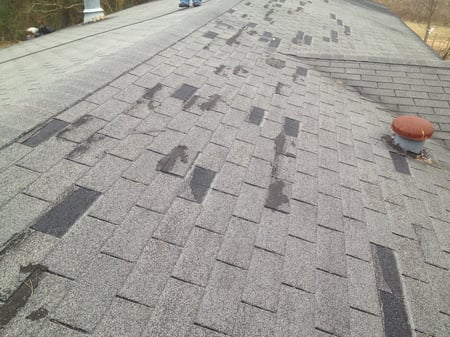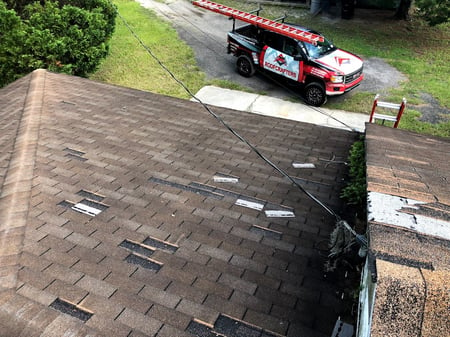Your Roof & Wind Resistance
December , 2023 | 6 min. read

Wind, a relentless adversary, has the potential to wreak havoc on your home, making the concept of wind resistance in roofing an important aspect of your safety, and your home’s durability. From hurricanes sweeping coastal regions to gusts sweeping across plains, the impact of wind on roofs is a critical consideration for homeowners and builders alike.
At RoofCrafters, we can tell you that the strength of a roof against these forces doesn't just safeguard the home itself; it shields your family and possessions from potential harm, ensuring a haven even amidst the most turbulent weather. So, understanding wind resistance in roofing is pretty important.
When we’re talking about wind, we really mean wind. Not the light, breezy summer air that tickles your face while you drive with your windows down - we mean the brutal, harsh force of nature type of wind that makes your shutters do the boogie against your windows and causes your shingles to fly off into the neighbor's pool for a quick dip.
So, if you’ve got a concern or 2 about your roof’s capability to withstand turbulent winds such as these (I mean, shingles going for a swim all on their own does sound pretty spooky), you’re in the right place. Read ahead to learn what wind resistance means when it comes to your roof, why it's important, and some telltale signs that your roof may be lacking proper resistance. Let’s get started!
What Is Wind Resistance in Roofing?

Wind resistance in roofing refers to the ability of a roof or its components to withstand the force of wind without sustaining damage. It involves various factors:
.png?width=1200&height=200&name=Recommended%20Reading%20(58).png)
Materials: The type of roofing material used can significantly affect wind resistance. Some materials, like asphalt shingles or metal panels, may be more resistant to wind uplift than others.
Installation: Proper installation is crucial for wind resistance. If the roofing materials aren't installed correctly or securely, they can be more prone to damage during high winds.
Design and structure: The shape and design of the roof, including its slope, overhangs, and connections to the structure, can impact wind resistance. Hip roofs, for instance, are generally more wind-resistant than gable roofs due to their aerodynamic shape.
Fastening and attachment: The method used to fasten roofing materials to the structure plays a significant role. Properly secured materials with appropriate fasteners and attachments can enhance wind resistance.
Local building codes: Building codes often dictate specific wind resistance requirements based on the region's typical wind speeds and other factors. Roofing materials and installation methods must meet these codes to ensure adequate wind resistance.
In areas prone to hurricanes, tornadoes, or high-wind events, it's particularly important for roofs to be designed and constructed with strong wind resistance in mind to protect the structure and its occupants. Regular maintenance and inspections are also essential to ensure continued wind resistance over time.
Why Is Wind Resistance Important?

Wind resistance in roofing is crucial for several reasons:
.png?width=1200&height=200&name=Recommended%20Reading%20(59).png)
Structural integrity: A roof's primary function is to protect a structure from the elements. High winds can exert substantial pressure on a roof, potentially leading to structural damage if the roofing materials aren't adequately resistant. A wind-resistant roof helps maintain the structural integrity of the entire home.
Safety: A roof that can withstand high winds is safer for the family inside the home. It reduces the risk of roof components becoming dislodged or damaged during a storm, which could pose a danger to people inside or nearby.
Home protection: A wind-resistant roof helps safeguard the entire home. A compromised roof can allow water, debris, or even pests to enter, potentially causing extensive damage to belongings, interior structures, and insulation.
Cost savings: Investing in a wind-resistant roof can save money in the long run. It reduces the likelihood of damage during storms, minimizing the need for costly repairs or replacements due to wind-related incidents.
Insurance purposes: Many insurance companies consider the wind resistance of a roof when determining premiums. A more wind-resistant roof might qualify for lower insurance rates, as it's considered less risky in areas prone to high winds.
Compliance with building codes: Local building codes often mandate specific wind resistance standards for roofing materials and construction methods. Ensuring compliance not only guarantees safety but also avoids potential fines or penalties for not meeting these requirements.
Ultimately, wind resistance in roofing isn't just about protecting the roof itself; it's about safeguarding the entire home, loved ones, and the contents within, while also ensuring compliance with safety standards and potentially reducing long-term maintenance costs.
Is Your Roof Lacking Proper Wind Resistance?

Some signs you can look out for that can indicate that your roof might be lacking proper wind resistance include:
.png?width=1200&height=200&name=Recommended%20Reading%20(60).png)
Missing or loose shingles: If you notice shingles missing or others that seem loose or lifted after a windy day, it could indicate poor wind resistance. Shingles should be securely fastened to withstand high winds.
Visible damage: Look for visible signs of damage, such as cracked, curled, or torn shingles. These issues can compromise the integrity of the roof and its ability to resist wind.
Water leaks: Wind damage might create openings in the roof, allowing water to seep in. Check for water stains on ceilings or walls, as this could signal a compromised roof due to wind damage.
Debris in gutters: After a windy day or storm, check your gutters for an unusual amount of debris, especially pieces of roofing materials. This suggests that your roof might have suffered damage or lost some of its protective elements.
Sagging or dips: Visually inspect the roofline for any areas that appear to sag or dip, as this could indicate weakened or damaged sections.
Loose flashing or vents: Loose flashing, vents, or other roof accessories can be a sign of poor installation or damage from high winds.
Granules in gutters: If you notice an excessive amount of granules from asphalt shingles in the gutters, it could indicate that the shingles are aging or have been damaged by wind, making them more susceptible to further damage.
If you notice any of these signs, it's essential to have your roof inspected by a professional roofer. They can assess the extent of the damage and recommend repairs or replacements to ensure your roof has adequate wind resistance and is protecting your home effectively. Regular inspections, especially after severe weather events, can help catch wind damage early and prevent more extensive issues.
The Crucial Role of Wind Resistance in Roofing
As you now know, wind resistance in roofing is a critical aspect of home safety, structural integrity, and long-term cost savings. A roof's ability to withstand high winds ensures protection for the entire structure, your family, and your belongings. Signs of poor wind resistance, such as loose or missing shingles, water leaks, or visible damage, indicate vulnerabilities that need prompt attention.
Investing in wind-resistant roofing materials, proper installation, and regular inspections can mitigate risks associated with wind damage. A resilient roof not only safeguards against weather elements but also aligns with building codes, potentially reduces insurance premiums, and minimizes the need for costly repairs or replacements in the future.
Prioritizing wind resistance in roofing is not merely about fortifying the roof itself; it's about fortifying the entire home against the forces of nature, ensuring safety, security, and peace of mind for those inside. If you believe your roof is suffering the consequences of improper wind resistance, be sure to hit the “Schedule an Inspection” button down below, and one of our experts will walk you through your options!
My name is Cassie, and I’m the Content Manager here at RoofCrafters. I was born and raised in Chicago, Illinois, and made my way out to Florida post-college graduation. I’m incredibly passionate about writing and creating valuable content that helps others with the collaboration of my marketing team. When I’m not working, I enjoy shopping (a little too much), spending time at the beach, and reading!



